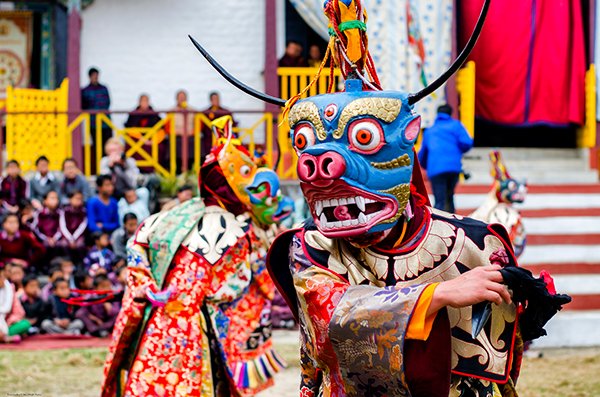Sikkim has received worldwide recognition for its indigenous culture and traditions. Just like any other state, Sikkim also has a distinct cultural heritage made up of its unique folk dances and music forms.
The folk dances, music, and art are an inseparable part of Sikkim. People planning a trip to this beautiful land should know about these things to have a better experience. The population of Sikkim is divided into three groups namely Nepalis, Bhutias and Lepchas. So, these groups have different festivities and cultures.
Sikkim tourism is also increasing with the enhancing awareness of its culture and landscape. Let’s know about a myriad of dance and music forms which amplify the beauty of this state.
Folk Dances of Sikkim:
Dance forms of Sikkim are usually associated with nature and its admiration. Locals perform some of these for good harvest while others for good fortune and obtaining nature’s blessings.
Diverse dance forms depict the feeling of love, mutual respect, harmony and unity between multiracial groups residing in this mountainous state. Sikkimese people use colorful masks and costumes to perform most of the folk dances.
- Chu Faat Dance of Lepchas:
Sikkim’s people respect Mt. Kanchenjunga along with its other companion peaks like Mt. Pandim, Mt. Kabru and Mt. Simbrum. The people of the Lepcha community perform the special Chu Faat dance for these mountains.
It is a distinct celebration in which locals show their gratitude to these mighty peaks for bestowing the precious gifts like sacred texts, medicines, minerals, and salts.
The dancers illustrate the power of majestic mountains by moving around gracefully while carrying butter lamps and rings of green bamboo. It is performed on the 15th of the 7th month of Buddhist calendar.
- Singhi Chaam Dance of Bhutias:
The history of the Bhutia community connects them with showing love and respect towards animal species. Bhutias were herdsmen in the past, and that’s why they believe in the mythical figure of snow lion which is found in Trans Himalayas.
The holy Kanchendzonga and the four peaks associated with it are the symbols of these fierce snow loins. The Bhutias wear costumes of snow loins and display their power and grandeur by indulging into mock fights in this dance.
- Maruni Dance of Nepalis:
Maruni Dance is one of the ancient dance forms of Sikkim. In olden times, folks of the Nepali community used to perform this dance on Tihar festival. But, in recent years every community of Sikkim performs Maruni dance on happy occasions like marriage and birth.
The dancers are draped in vibrant costumes and heavy ornaments to display the victory of good over evil. They are accompanied by a funny clown known as Dhatu Waray at the time of visiting houses after the dance. The dancers move on the beats of a glorious nine instruments orchestra which is called Naumati Baja.
- Khukhuri Naach of Nepalis:
Khukhuri dance form depicts the courage and bravery of Sikkimese people. The word “Khukhuri” means bravery in the Nepali language. Soldiers or strong males of the community perform this dance with a special weapon also known as Khukhuri.
The warriors display quick and strong moves in the Khukhuri Naach. Locals believe that this dance form helps in enhancing the courage and gallantry of the state.
- Tashi Yangku Dance of Bhutias:
The Bhutias have strong faith in gods and goddesses who control the seasons and natural occurring like floods, landslides, earthquake etc. They believe that God is the only source of providing natural bounty and prosperity as well as natural disasters.
Bhutia people try to appease these gods and goddesses and request them to keep showering the blessings through natural peace. They perform Tashi Yangku Dance to please the gods. Monks utter sacred hymns and chants on which the dancers move rhythmically. According to the locals, this performance brings good fortune and peace to the land.
Folk Music of Sikkim:
The folk music of Sikkim is as attractive and distinct as its dance forms. It is one of the reasons for the growth of Sikkim tourism. The folk music has its roots in the beats of animalistic deities of the early ages.
In recent times, the Carnatic musical style has become dominant in the state. The melodies are collectively known as Sikkim Gharana of Carnatic music. It includes the Sopana form that is the dramatic and slow rendition of the various ragas and talas.
The folk songs mostly revolve around agriculture, description of natural beauty, animals and its praises. The lyrics of the songs are usually in Nepali or other Sikkimese languages.
The songs sung during the performance of Ottamthullal dance are simple with easy dialogues and tones as the dancers have to sing them along with performing dance.
Pulluvan Pattu is also a famous form of folk music in Sikkim. The Pulluvar community who worships the snake god perform this dance. These songs are sung in order to please the serpent deity and to receive blessings. People sing these especially during the snake festival honouring the snakes in the popular temples.
The music is accompanied by the use of various instruments such as dranyen (an instrument producing melodious music with 6 strings), gyumang (74 stringed instruments), flute, drums and cymbals. Some other ancient musical instruments are:
Susira: It is a wind instrument parallel to the flute which the people play by blowing air in it.
Ghana: It is a solid type of instruments which is beaten by metal sticks in order to produce melodious sounds.
Vandya – Instruments of Percussion: This musical instrument resembles a “damroo” which is a hollow cylindrical wood. Both the ends are covered by animal skin, and people beat the ends to create wonderful music.
So, enjoy your trip to Sikkim by listening to these awesome songs and watching the folk dance performances. If you are a fan of music and dance then, you are going to love Sikkim! Have a fun filled trip!

